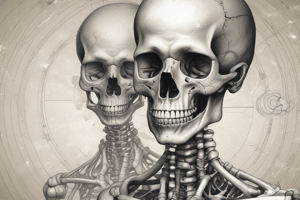Podcast
Questions and Answers
Which of the following describes the characteristic fusion of digits associated with Apert syndrome?
Which of the following describes the characteristic fusion of digits associated with Apert syndrome?
- Syndactyly (correct)
- Mesomelia
- Rhizomelia
- Micromelia
What is the term used to describe the shortening of the entire limb, affecting all segments?
What is the term used to describe the shortening of the entire limb, affecting all segments?
- Micromelia (correct)
- Rhizomelia
- Mesomelia
- Acromelia
Which term refers to the shortening of the middle segment of a limb, such as the forearm or lower leg?
Which term refers to the shortening of the middle segment of a limb, such as the forearm or lower leg?
- Micromelia
- Rhizomelia
- Mesomelia (correct)
- Syndactyly
Which of the following terms describes the shortening of the proximal segment of a limb, such as the humerus or femur?
Which of the following terms describes the shortening of the proximal segment of a limb, such as the humerus or femur?
Which of the following is NOT a characteristic feature associated with Apert syndrome?
Which of the following is NOT a characteristic feature associated with Apert syndrome?
Which of the following conditions is often associated with a rocker-bottom foot?
Which of the following conditions is often associated with a rocker-bottom foot?
Which of the following is a possible cause of Sirenomelia?
Which of the following is a possible cause of Sirenomelia?
Which of the following is a defining characteristic of VACTERL association?
Which of the following is a defining characteristic of VACTERL association?
Which skeletal dysplasia is characterized by rhizomelia, macrocephaly, and a narrow thorax?
Which skeletal dysplasia is characterized by rhizomelia, macrocephaly, and a narrow thorax?
Which type of skeletal dysplasia is known for its characteristic "trident hands"?
Which type of skeletal dysplasia is known for its characteristic "trident hands"?
What type of limb length discrepancy is described as abnormally short bones in the middle part of the limb?
What type of limb length discrepancy is described as abnormally short bones in the middle part of the limb?
Which skeletal dysplasia is associated with a narrow thorax, polydactyly, and pelvic/renal anomalies?
Which skeletal dysplasia is associated with a narrow thorax, polydactyly, and pelvic/renal anomalies?
What type of limb length discrepancy is defined as shortened bones in all limbs?
What type of limb length discrepancy is defined as shortened bones in all limbs?
Which of the following conditions is NOT associated with micromelia?
Which of the following conditions is NOT associated with micromelia?
Which of the following is a characteristic feature of Achondrogenesis?
Which of the following is a characteristic feature of Achondrogenesis?
Which skeletal dysplasia is associated with a bell-shaped thorax, curved or bowed long bones, and hypomineralization?
Which skeletal dysplasia is associated with a bell-shaped thorax, curved or bowed long bones, and hypomineralization?
Which of these skeletal dysplasias is NOT associated with a narrow thorax?
Which of these skeletal dysplasias is NOT associated with a narrow thorax?
What type of limb length discrepancy is described as abnormally short bones in the proximal part of the limb?
What type of limb length discrepancy is described as abnormally short bones in the proximal part of the limb?
What is the specific type of limb shortening characterized by shortening of the distal portion of the limbs?
What is the specific type of limb shortening characterized by shortening of the distal portion of the limbs?
Which skeletal dysplasia is primarily associated with the abnormal shortness of the middle portion of the limbs like the radius, ulna, tibia, and fibula?
Which skeletal dysplasia is primarily associated with the abnormal shortness of the middle portion of the limbs like the radius, ulna, tibia, and fibula?
Which condition is characterized by the soft tissue or fusion of digits and can be associated with triploidy?
Which condition is characterized by the soft tissue or fusion of digits and can be associated with triploidy?
Identify the condition that indicates shortening of the proximal portion of the limbs, particularly the femur and humerus.
Identify the condition that indicates shortening of the proximal portion of the limbs, particularly the femur and humerus.
What is a common finding in severe micromelia that impacts the thoracic cavity?
What is a common finding in severe micromelia that impacts the thoracic cavity?
Which of the following abnormalities does NOT result in limb shortening?
Which of the following abnormalities does NOT result in limb shortening?
Which skeletal condition is considered lethal due to its severe prenatal manifestations and association with lung development issues?
Which skeletal condition is considered lethal due to its severe prenatal manifestations and association with lung development issues?
Which condition is primarily characterized by abnormal shortness of the limbs but can also involve various forms of limb abnormality, including associated polydactyly?
Which condition is primarily characterized by abnormal shortness of the limbs but can also involve various forms of limb abnormality, including associated polydactyly?
Which of the following is a characteristic feature of nonlethal skeletal dysplasias?
Which of the following is a characteristic feature of nonlethal skeletal dysplasias?
Which feature is commonly assessed to determine the severity of limb shortening in fetuses?
Which feature is commonly assessed to determine the severity of limb shortening in fetuses?
Study Notes
Skeletal Dysplasia Assessment
- Long bones should be measured; limb lengths below two standard deviations indicate skeletal dysplasia.
- Evaluate bone contour for thickness, abnormal curvature, fractures, and ribbonlike appearances.
- Assess ossification; hypomineralization leads to decreased shadowing on imaging.
- Analyze thoracic circumference and shape; long and narrow or bell-shaped chests indicate specific dysplasias.
- Check for hand and foot anomalies like talipes and polydactyly.
- Examine facial profile for anomalies such as clefts, frontal bossing, and hypertelorism.
Non-Lethal vs. Lethal Skeletal Dysplasias
- Non-lethal Achondroplasia:
- Normal intelligence, rhizomelia, macrocephaly, trident hands, depressed nasal bridge, and frontal bossing.
- Lethal Thanatophoric Dwarfism:
- Most common lethal skeletal dysplasia characterized by bowed long bones, hypomineralization, and narrow thorax.
Specific Disorders and Features
- Achondrogenesis (Lethal):
- Hypomineralization, narrow thorax, short trunk, micrognathia, and polyhydramnios.
- Short Rib-Polydactyly Syndrome:
- Types I, II, and III associated with narrow thorax, hypomineralization, polydactyly, and various organ anomalies.
- Asphyxiating Thoracic Dysplasia:
- Known as Jeune’s syndrome; features include narrow thorax, polydactyly, rhizomelia, and lethal pulmonary hypoplasia.
- Ellis-van Creveld Syndrome:
- Polycactyly, short limbs, narrow thorax, and heart malformations, primarily seen in the Amish community.
Osteogenesis Imperfecta
- Characterized by curved long bones, hypomineralization, and recurrent fractures.
- Four classifications: Types I to IV, with Type II being the most severe and lethal.
Management and Diagnostic Techniques
- Monitor family history, advanced paternal age, and take serial images for limb growth.
- Assess amniotic fluid volume and limb lengths to identify periods of growth.
- Utilize alkaline phosphatase assay for Congenital Hypophosphatasia diagnosis, involving fetal blood sampling.
Differential Diagnoses and Growth Indicators
- Micromelia refers to abnormally short limbs and can be a sign of several skeletal dysplasias.
- Rhizomelia denotes shortening of the proximal limbs, acromelia signifies shortening of distal limbs.
- Evaluate fetal skeletal abnormalities such as clubfoot (talipes) and syndactyly (fusion of digits).
Other Syndromes and Conditions
- Sirenomelia: Fusion of lower extremities, often associated with renal agenesis and oligohydramnios.
- VACTERL Association: A cluster of anomalies including vertebral defects, anal atresia, cardiac anomalies, and limb dysplasia.
- Amniotic band sequence, or synechiae, can cause various limb deformations.
Doppler Evaluation
- Assess umbilical artery and vein Doppler waveforms for fetal and maternal influences.
Key Observations in Prenatal Imaging
- High FL/AC ratios can indicate skeletal dysplasia; careful ratio analysis is crucial for accurate age estimation.
- Evaluate thorax shape and rib lengths, as these correlate with potential lethality in skeletal dysplasias.
Conclusion
- Skeletal dysplasia involves complex abnormalities in bone development and requires comprehensive assessment through imaging, growth monitoring, and careful evaluation of associated anomalies.
Studying That Suits You
Use AI to generate personalized quizzes and flashcards to suit your learning preferences.
Related Documents
Description
Learn how to assess skeletal dysplasia through radiography by measuring bone lengths, examining bone contour, estimating degree of ossification, and evaluating thoracic circumference.




